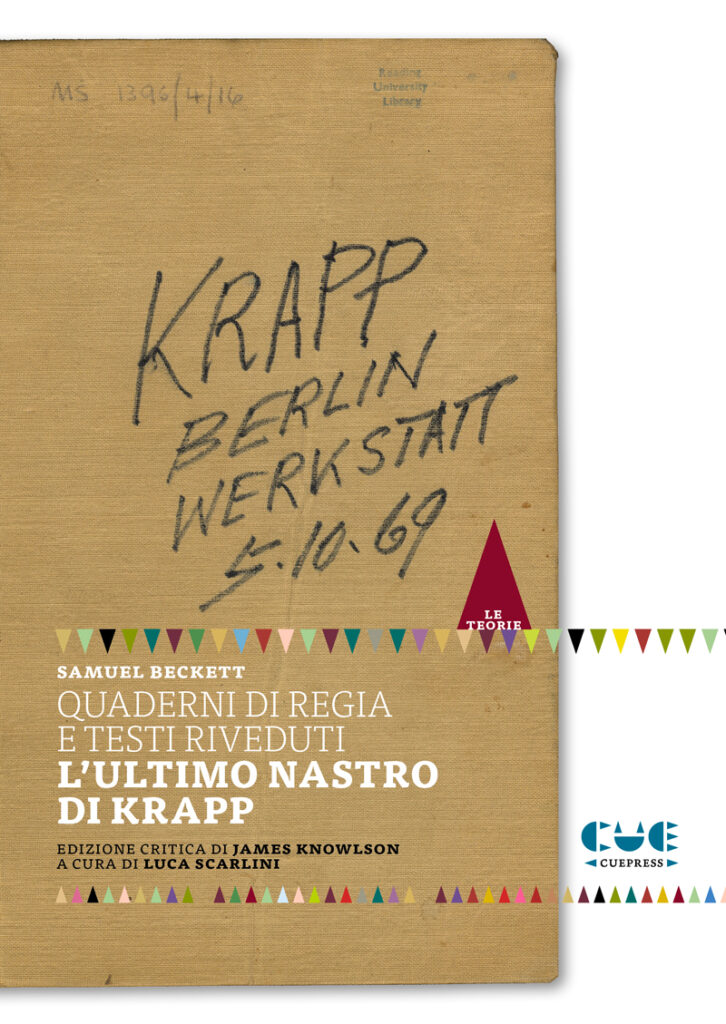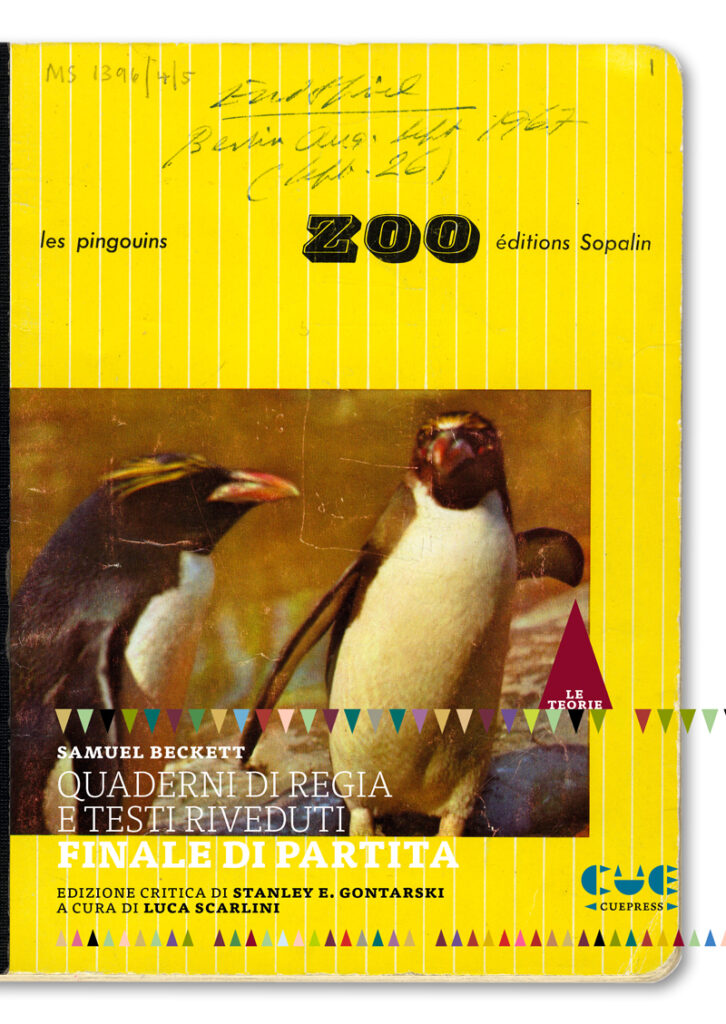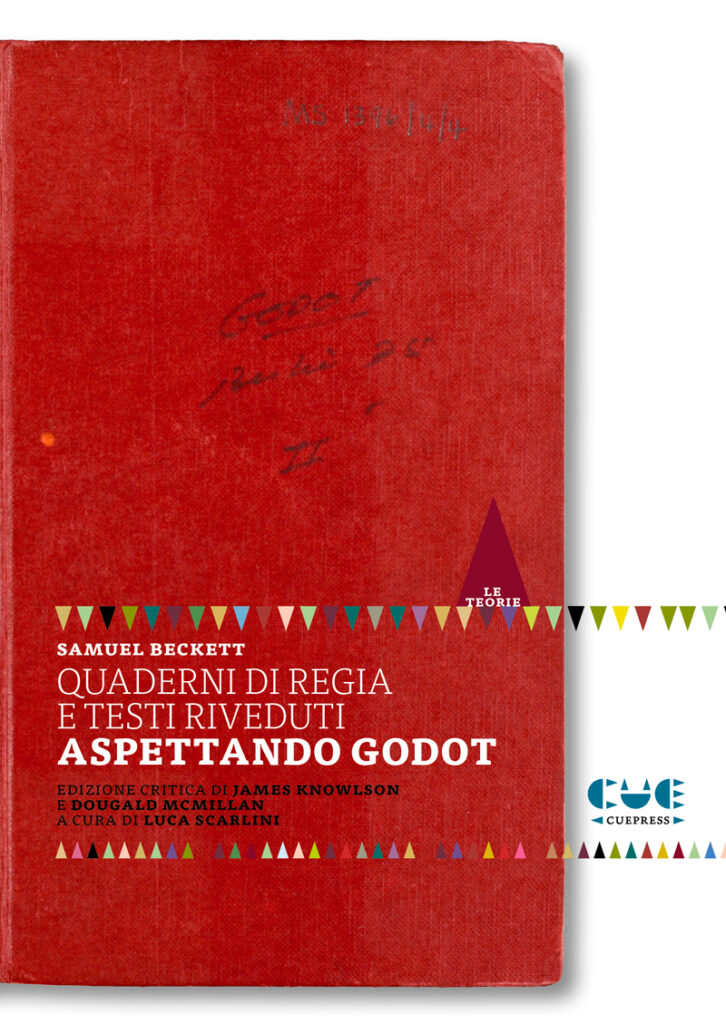Wipes dream away with hand
Mel Gussow, «New York Times»
In our many conversations over the years, Samuel Beckett was always reluctant to discuss the meaning and philosophy behind his work, preferring to stand on the principle of no exegesis where none intended. When pressed, he would talk about the genesis of individual plays and about production and performance. As it turns out, production and performance were central to his concept of his art. Years after he began writing plays, he became an active participant in the theatrical process and a consummate director of his own work. What began as an act of utmost privacy reached into the rehearsal room, where the author, watching actors play his roles, would distill and clarify his plays.
While directing his plays in Germany and England, Beckett kept production notebooks, which are being published in facsimile form together with his final revised texts of the plays. The first volumes of The Theatrical Notebooks of Samuel Beckett deal with Endgame and Krapp’s Last Tape. The notebook on Waiting for Godot, though labeled Volume One, is scheduled to be published in England this spring, and a book on the shorter plays will follow. Beckett himself was actively involved in the project, in the case of Endgame and Krapp’s Last Tape going over the text line by line with the editors. With the publication of the notebooks, we now have a more authoritative view of both the art and the artist.
S. E. Gontarski, the editor of the Endgame notebook, says, «Beckett discovered that theater allowed him to paint (or sculpt), that is, to work directly with form». As is abundantly clear from these volumes, Beckett’s art underwent a continuing evolutionary process. Just as museum conservators use infrared instruments to study paintings and to reveal underlying aspects of an artist’s creative process, James Knowlson — who is the general editor of the series as well as the editor of the Krapp’s Last Tape volume — and Mr. Gontarski use their infrared scholarship to uncover the pentimento behind the plays.
The editors, both of whom are Beckett scholars, decipher Beckett’s handwriting (in English, French and German) and even read beneath his erasures. The texts are densely documented and footnoted, an approach that could have led to a dissection of minutiae. Instead, it leads to illumination.
Although directors have published production logbooks, it is rare that a playwright provides such material. Beckett’s notebooks bring us closer to the author’s mind and, tangentially, to his life. We can see his careful, deliberative method and his serious concern for structure. Those who think of him solely as an intuitive artist will be surprised at the meticulous quality of his writing, self-editing and rewriting. At the same time, it is evident that he was neither dogmatic nor didactic. As Mr. Knowlson says in a prefatory note, «The material reveals a flexibility and an openness of approach that is often considered alien to Beckett’s ways of working in the theater.» Appropriately, the editor views the plays as a «living organism», not as works cast in stone.
Although Beckett wanted to protect his work from deconstructionists, he allowed for a certain amount of directorial (and actorial) interpretation, his own as well as that of others. The journals offer Beckett in purest form, with an added aspect of mystery, of literary sleuthing, as the editors lead us into the intricacies of the author’s choices. We might be sitting next to Beckett as he explores and learns about his work.
Some of the material in these volumes has been previously available in books like Beckett in the Theater, by Dougald McMillan and Martha Fehsenfeld, and Mr. Knowlson’s Theater Workbook on Krapp’s Last Tape. The current publication brings together a wealth of information in a finely detailed and highly readable format. These notebooks add to the expanding Beckett library, which now also includes the early, previously unpublished novel Dream of Fair to Middling Women. That book, published late last year in Dublin, is scheduled to be brought out here by Arcade Publishing in the spring.
So many of the alterations in the plays derive from Beckett’s impatience, his apparent urge to make the performance flow more swiftly and precisely. Dialogue is cut and actions are added. In the revised Endgame, Clov the servant is more physically active; Hamm the master yawns less. In his stage directions, Beckett specifies more clearly the moods and reactions of his characters while also stressing the significance of aural and visual imagery as well as of motifs. Both plays seem funnier, though less clownish. Hamm is no longer described as having a very red face, and Krapp does not have a purple nose or trousers that are too short. There is more attention to Krapp’s attachment to his tape recorder and less stage business with bananas. The title character does not sing Now the Day Is Over, because Beckett felt the singing was self-conscious. These changes are part of a larger scheme in which Beckett analyzes the intimations he has aroused and communicates them more evocatively to the audience. In all respects, he expands the dimensions of his theater.
Beckett said that the line «Nothing is funnier than unhappiness» was the most important sentence in Endgame. Reading the author’s notebook, one can see an increasing emphasis on the play as a comedy of pessimism, with the comedy contradicting the dourness of some productions by other directors. Similarly, in Krapp he pointed to the line «The earth might be uninhabited» as pivotal. That line denotes Krapp’s abject isolation, his «incarceration in self», as a man unable to escape his past and equally unable to comfort himself in the present. Krapp is, in Beckett’s words, a «dream-consumed man». Although most of Beckett’s changes were made for clarity, in at least one instance he was moved by discretion. In Endgame, Hamm originally said, «I feel a little queer». At the request of the actor Patrick Magee, Beckett changed «queer» to «strange».
The book on Krapp is particularly instructive, because the play is so brief, self-contained and autobiographical. It is also the play with which Beckett was most involved in production. A scant eight pages in the present edition, Krapp is parsed in the editor’s notes for every undercurrent. It is one of the few Beckett pieces inspired by an actor, in this case Magee. Drawn by his mellifluous voice, the author initially referred to the play as «Magee Monologue». Beckett was also drawn by his own curiosity about the tape recorder, realizing that he could use it as a mechanical equivalent of a photographic album, as a way to transport the character back to his past. That tape recorder could have proved to be a problem in performance; the actor playing the title role has to turn it on and off, forward and backward, exactly on cue. The machine, we are told, is generally operated by an offstage assistant and not by the actor onstage.
There is a triple-edged quality to the reflections as Krapp at the age of 69 listens to himself at 39 commenting on his even more youthful self. Two scenes are crucial to an understanding of Krapp. An epiphany is experienced by the character (as it was in life by Beckett) standing at night on the jetty at Dun Laoghaire and witnessing a life-transforming «memorable equinox». Listening to the tape conjuring that event, Krapp now has a «violent reaction». Equally important is the boating scene, in which the speaker recalls a single romantic interlude and bids «farewell to love». In the revised version, Krapp «wipes dream away with hand, broods, shudders». Throughout the revisions, made over a period of years, Beckett underlined the play’s three primary themes, «solitude, light-darkness and woman» – and in Endgame, depletion and deterioration. And in a curious personal note, for one production of Krapp Beckett brought in his own bedroom slippers for the actor to wear. He wanted him to have the proper shuffle.
In his notebooks, Beckett assiduously warns against stylization and sentimentality. As he said during a production of Endgame: «I would like as much laughter as possible in this play. It is a playful piece». An observer interpreted this as meaning «laughter of his characters, not the audience’s amusement», though, of course, one would lead to the other. Directors of Endgame and Krapp’s Last Tape would certainly benefit from using The Theatrical Notebooks as production guides. They are invaluable maps of Beckett country.
Collegamenti


